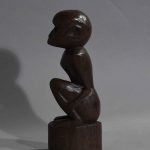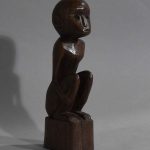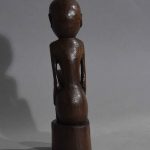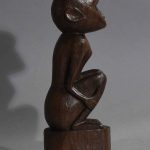ACK 0219-11
Sumba Ancestor statue, Indonesia
Sumba lies in the midst of Nusa Tenggara Timor, also known as the Eastern Lesser Sunda Islands. Once known as ‘Sandal wood Island’.
The Sumba (or Sumbese) people have been able to retain much of their culture despite foreign influences that arrived long ago on the East Nusa Tenggara Islands. And according to a myth of origin, they come from two ancestors, Hawu Meha and Humba Meha. Hawu Meha gave birth to the Sawunese who initially lived in Sumba Island but later migrated to the small Sawu Island. The offspring of Humba Meha remained in Sumba.
The exact time Sumba Island begin to populate is not known. According to the Marapu mythology, the first people down through the stairs from the sky to the north of the island.[6] Geneticists claim that the ancestors of the Sumba people really did originally inhabit the northern coast, and only then followed by the rest of the Sumba Island. Since the end of Neolithic period, settlers have created megalithic structures. Moreover, this tradition continued until the 20th century.
This beautiful and delicately carved wooden figure symbolizes an ancestor sculpture in the traditional style of a statue from Sumba has been carefully housed and stored at a house altar and depicts a human figure with a head with animal traits. He sits on a platform with his legs bent. His hands cover his knees. The head is heart shaped. The chin protrudes slightly. The eyes are small and round, the mouth is closed, and the nose extends into that part of the eyebrows. The ears are high up on the head, giving the head more appearance as an animal. The buttocks and limbs are beautifully styled. The genitals appear masculine.
Age: Est. 1940 – 1950s.
Measure: H: 23, W: 5,5, D: 8 cm.
Condition: In good vintage condition commensurate with age and use. Since this figure has been stored at a house altar, it still appears in a beautiful, dark-glowed glow with no damage or insect bite.
Provenance: Acquired from Dutch private collection, field collected in the village of Rattengaro in 2007.
Literature and reference:
Authors as Davis P. McAllester, Dr. Peter Bellwood, Sir. Sidney Moko Meal and Steven G. Alpert found on https://www.artoftheancestors.com/sumba
Similar figures can be found on Ancestor figures in ‘Art of Indonesia’ in the Musée du quai Branly, Paris. The Dallas Museum of Art, Yale University Art Gallery, Museum of Fine Arts, Boston, The Metropolitan Museum of Art, de Young Museum, Nationaal Museum van Wereldculturen, Musée du Quai-Branly, and Museum der Kulturen Basel.
Request price for Sumba Figure




